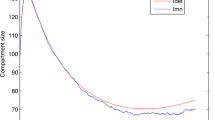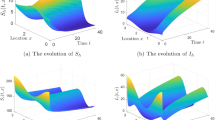Abstract
In this paper, we propose a new mathematical model describing the dynamics of mosquito-borne epidemics. The main novelties of the proposed model in comparison to the previous literature are twofold. On the one hand, the inclusion of the quarantine control measure applied to the human population and, on the other hand, the incorporation of the impact of environmental variations. The resulting model is governed by two blocks of Ito–Lévy coupled stochastic differential equations driven by Gaussian noise and six independent compensated Poisson processes. Based on the Lyapunov approach and the stop** time method, we first address the well-posedness of the proposed model. Then, by means of stochastic computational techniques, we establish certain asymptotic properties pertaining to the extinction and persistence in the mean of the infected component of the solution. Finally, we provide the outcome of some numerical experiments, to corroborate our theoretical results and highlight the influence of the quarantine measure and the discontinuous environmental noise on the infectious-disease dynamics.






Similar content being viewed by others
Data availability
Not applicable.
References
Abdelrazec A, Bélair J, Shan C, Zhu H (2016) Modeling the spread and control of dengue with limited public health resources. Math Biosci 271:136–145
Abushouk AI, Negida A, Ahmed H (2016) An updated review of Zika virus. J Clin Virol 84:53–58
Agusto F, Khan M (2018) Optimal control strategies for dengue transmission in Pakistan. Math Biosci 305:102–121
Bakary T, Boureima S, Sado T (2018) A mathematical model of malaria transmission in a periodic environment. J Biol Dyn 12(1):400–432
Bertoin J (1996) Lévy processes. Cambridge University Press, Cambridge
Cai L, Guo S, Li X, Ghosh M (2009) Global dynamics of a dengue epidemic mathematical model. Chaos Solit Fractals 42(4):2297–2304
Chitnis N, Cushing JM, Hyman J (2006) Bifurcation analysis of a mathematical model for malaria transmission. SIAM J Appl Math 67(1):24–45
Chitnis N, Hyman JM, Cushing JM (2008) Determining important parameters in the spread of malaria through the sensitivity analysis of a mathematical model. Bull Math Biol 70(5):1272–1296
Conti AA (2008) Quarantine through history. International Encyclopedia of Public Health, Academic Press, p 454
Din A, Sabbar Y, Wu P (2024) A novel stochastic Hepatitis B virus epidemic model with second-order multiplicative α-stable noise and real data. Acta Math Sci 44(2):752–788
Esteva L, Vargas C (1998) Analysis of a dengue disease transmission model. Math Biosci 150(2):131–151
Esteva L, Vargas C, Yang HM (2019) A model for yellow fever with migration. Comput Math Methods 1(6):1059
Ghanbari B, Kumar S (2024) A study on fractional predator–prey–pathogen model with Mittag–Leffler kernel-based operators. Numer Methods Partial Differ Equ 40(1):22689
Gokila C, Sambath M (2021) The threshold for a stochastic within-host CHIKV virus model with saturated incidence rate. Int J Biomath 14(06):2150042
Haas CN (2014) On the quarantine period for Ebola virus. PLoS Curr 6
Hays JN (2005) Epidemics and pandemics: their impacts on human history. Abc-clio, Santa Barbara
Iftikhar M, Sohail A, Ahmad N (2019) Deterministic and stochastic analysis of dengue spread model. Biomed Eng Appl Basis Commun 31(03):1950008
Jafari N, Shahsanai A, Memarzadeh M, Loghmani A (2011) Prevention of communicable diseases after disaster: a review. J Res Med Sci 16(7):956
Kaliraj K, Aswini U, Ravichandran C, Logeswari K, Nisar KS (2024) An investigation of fractional mixed functional integro-differential equations with impulsive conditions. Discontinuity Nonlinearity Complex 13(01):189–202
Kermack WO, McKendrick AG (1927) A contribution to the mathematical theory of epidemics. Proc R Soc Lond Ser A 115(772):700–721
Kermack WO, McKendrick AG (1932) Contributions to the mathematical theory of epidemics. II.-The problem of endemicity. Proc R Soc Lond Ser A 138(834):55–83
Khan MA, Ullah S, Kumar S (2021) A robust study on 2019-nCOV outbreaks through non-singular derivative. Eur Phys J Plus 136:1–20
Kiouach D, Sabbar Y, El-idrissi SEA (2021) New results on the asymptotic behavior of an SIS epidemiological model with quarantine strategy, stochastic transmission, and Levy disturbance. Math Methods Appl Sci 44(17):13468–13492
Kumar S, Kumar A, Samet B, Dutta H (2020) A study on fractional host-parasitoid population dynamical model to describe insect species. Numer Methods Partial Differ Equ 2
Kumar S, Kumar R, Momani S, Hadid S (2023) A study on fractional COVID-19 disease model by using Hermite wavelets. Math Methods Appl Sci 46(7):7671–7687
Kumar S, Chauhan R, Momani S, Hadid S (2024) Numerical investigations on COVID-19 model through singular and non-singular fractional operators. Numer Methods Partial Differ Equ 40(1):22707
Kuniya T, Muroya Y (2015) Global stability of a multi-group SIS epidemic model with varying total population size. Appl Math Comput 265:785–798
Liu Q, Jiang D, Hayat T, Alsaedi A (2018) Stationary distribution and extinction of a stochastic dengue epidemic model. J Frank Inst 355(17):8891–8914
Mao X (2007) Stochastic differential equations and applications. Woodhead Publishing, Cambridge
Mao X, Marion G, Renshaw E (2002) Environmental Brownian noise suppresses explosions in population dynamics. Stoch Process Appl 97(1):95–110
Mehdaoui M, Alaoui AL, Tilioua M (2023a) Analysis of a stochastic SVIR model with time-delayed stages of vaccination and Lévy jumps. Math Methods Appl Sci 46(12):12570–12590
Mehdaoui M, Alaoui AL, Tilioua M (2023b) Dynamical analysis of a stochastic non-autonomous SVIR model with multiple stages of vaccination. J Appl Math Comput 69(2):2177–2206
Mehdaoui M, Alaoui AL, Tilioua M (2023c) Optimal control for a multi-group reaction–diffusion SIR model with heterogeneous incidence rates. Int J Dyn Control 11(3):1310–1329
Mehdaoui M, Lamrani Alaoui A, Tilioua M (2023d) Analysis of an optimal control problem for a spatio-temporal SIR model with nonlinear density dependent diffusion terms. Optim Control Appl Methods 44(4):2227–2256
Munusamy K, Ravichandran C, Nisar KS, Munjam SR (2024) Investigation on continuous dependence and regularity solutions of functional integrodifferential equations. Results Control Optim 14:100376
Ngwa GA, Shu WS (2000) A mathematical model for endemic malaria with variable human and mosquito populations. Math Comput Model 32(7–8):747–763
Nisar KS, Logeswari K, Ravichandran C, Sabarinathan S (2023) New frame of fractional neutral ABC-derivative with IBC and mixed delay. Chaos Solit Fractals 175:114050
Pan C-Y, Liu W-L, Su M-P, Chang T-P, Ho H-P, Shu P-Y, Huang J-J, Lin L-J, Chen C-H (2020) Epidemiological analysis of the Kaohsiung city strategy for dengue fever quarantine and epidemic prevention. BMC Infect Dis 20(1):1–9
Ravichandran C, Jothimani K, Nisar KS, Mahmoud EE, Yahia IS (2022) An interpretation on controllability of Hilfer fractional derivative with nondense domain. Alex Eng J 61(12):9941–9948
Sabbar Y, Khan A, Din A, Kiouach D, Rajasekar SP (2022a) Determining the global threshold of an epidemic model with general interference function and high-order perturbation. AIMS Math 7(11):19865–19890
Sabbar Y, Yavuz M, Ozkose F (2022b) Infection eradication criterion in a general epidemic model with logistic growth, quarantine strategy, media intrusion, and quadratic perturbation. Mathematics 10(22):4213
Sabbar Y, Zeb A, Kiouach D, Gul N, Sitthiwirattham T, Baleanu D, Pongsopa J (2022c) Dynamical bifurcation of a sewage treatment model with general higher-order perturbation. Results Phys 39:105799
Selvam A, Sabarinathan S, Sooppy Nisar K, Ravichandran C, Senthil Kumar BV (2024) Results on Ulam-type stability of linear differential equation with integral transform. Math Methods Appl Sci 47(4):2311–2323
Sun W, Xue L, Yan X (2018) Stability of a dengue epidemic model with independent stochastic perturbations. J Math Anal Appl 468(2):998–1017
Tumwiine J, Mugisha J, Luboobi LS (2007) A mathematical model for the dynamics of malaria in a human host and mosquito vector with temporary immunity. Appl Math Comput 189(2):1953–1965
ul Rehman A, Singh R, Singh J (2022) Mathematical analysis of multi-compartmental malaria transmission model with reinfection. Chaos Solit Fractals 163:112527
Van den Driessche P, Watmough J (2002) Reproduction numbers and sub-threshold endemic equilibria for compartmental models of disease transmission. Math Biosci 180(1–2):29–48
Veeresha P, Prakasha D, Kumar S (2020) A fractional model for propagation of classical optical solitons by using nonsingular derivative. Math Methods Appl Sci. https://doi.org/10.1002/mma.6335
Wang Y, Cao J (2014) Global dynamics of multi-group SEI animal disease models with indirect transmission. Chaos Solit Fractals 69:81–89
Wang L, Teng Z, Ji C, Feng X, Wang K (2019) Dynamical behaviors of a stochastic malaria model: a case study for Yunnan, China. Physica A 521:435–454
Witbooi PJ, Abiodun GJ, Schalkwyk GJ, Ahmed IH (2020) Stochastic modeling of a mosquito-borne disease. Adv Differ Equ 2020(1):1–15
World Health Organization (1995) Vector Control for Malaria and Other Mosquito-Borne Diseases: Report of a WHO Study Group. World Health Organization, Geneva
Yuan C, Jiang D, O’Regan D, Agarwal RP (2012) Stochastically asymptotically stability of the multi-group SEIR and SIR models with random perturbation. Commun Nonlinear Sci Numer Simul 17(6):2501–2516
Zhang X, Wang K (2013) Stochastic SIR model with jumps. Appl Math Lett 26(8):867–874
Zhang G, Li Z, Din A (2022) A stochastic SIQR epidemic model with Lévy jumps and three-time delays. Appl Math Comput 431:127329
Acknowledgements
This study is supported via funding from Prince Sattam bin Abdulaziz University project number (PSAU/2024/R/1445).
Funding
None.
Author information
Authors and Affiliations
Contributions
Conceptualization: YS, MM, MT; writing original draft: YS, MM, MT, KSN; software: MT, KSN; formal analysis: KSN; validation: MM, KSN. All the authors read and approved the manuscript.
Corresponding author
Ethics declarations
Conflict of interest
The authors declare that they have no Conflict of interest.
Additional information
Publisher's Note
Springer Nature remains neutral with regard to jurisdictional claims in published maps and institutional affiliations.
Rights and permissions
Springer Nature or its licensor (e.g. a society or other partner) holds exclusive rights to this article under a publishing agreement with the author(s) or other rightsholder(s); author self-archiving of the accepted manuscript version of this article is solely governed by the terms of such publishing agreement and applicable law.
About this article
Cite this article
Sabbar, Y., Mehdaoui, M., Tilioua, M. et al. Probabilistic analysis of a disturbed SIQP-SI model of mosquito-borne diseases with human quarantine strategy and independent Poisson jumps. Model. Earth Syst. Environ. (2024). https://doi.org/10.1007/s40808-024-02018-y
Received:
Accepted:
Published:
DOI: https://doi.org/10.1007/s40808-024-02018-y




